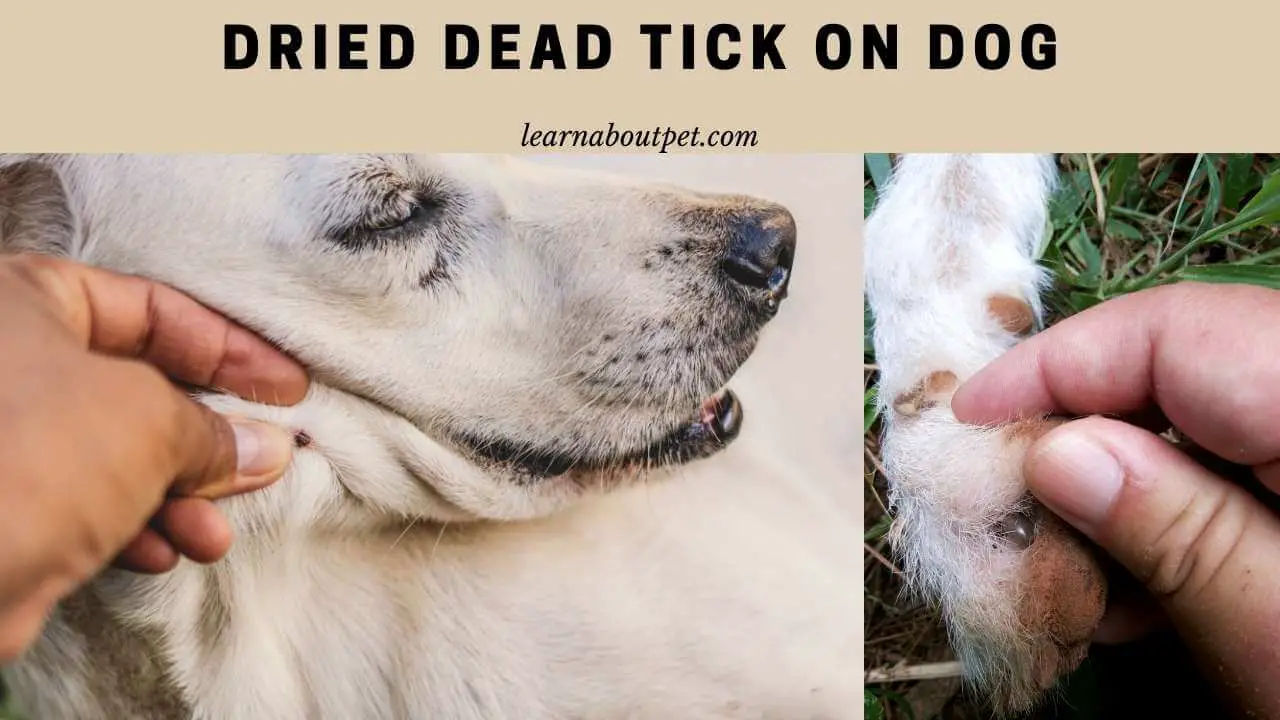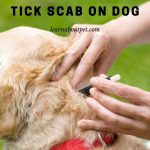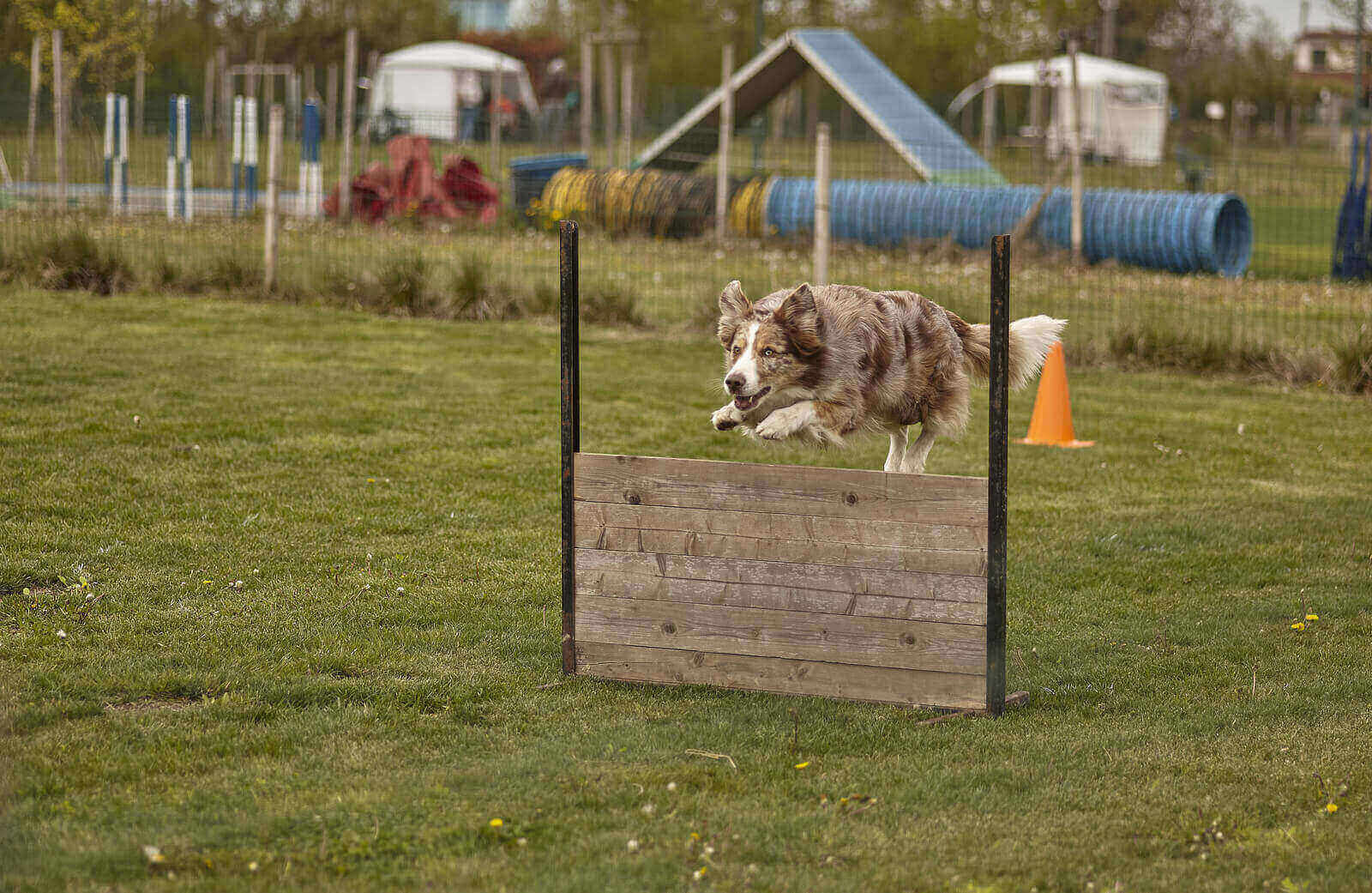Dogs are always inquisitive and smart by nature. They like to explore and enjoy the surroundings, territory marking part of it. Such adventures have their downsides also.
One such downside is the best companion sometimes brings along an unwelcome friend in the shape of a tick on its body or hidden in its furs.
Should I remove a dried dead tick on dog? When checking for ticks on your dog, if you happen to find a dried dead tick on dog, remove it as you would remove a live tick. The structure of the tick’s mouthpart allows it to hold onto the skin even though it might already be dead.

In this blog, we discuss exclusively the most common but frivolous problem of finding a dried up dead tick on dog and how to remove it, plus other remedies concerning the dried dead tick on dog.
Enjoy your reading and do let us know about your comments and queries. We shall be happy to be of any help to you.
How Does A Dog Tick Look Like?
For a pet owner, especially a dog owner, it is important to know how a dog tick looks like. There are cases where people have tried to remove body tags, moles, and even nipples, mistaking them as a tick.
The best source for ticks are pictures of embedded ticks on dogs on the internet and books. The use of a magnifying glass is strongly suggested to help in locating and inspecting small ticks easily.
Ticks can be found anywhere on the dog’s body, but their favorite location is where there is the least motion, like thick fur, head, ears, and folds under legs and even paws.
Some basic guidelines for the identification of a tick are given below.
- Size & shape: Generally small like a hard bump around 1 mm to 10 mm in size.
- Color Brown or black: The deer tick has an orange-colored rear body.
- Legs: 6 to 8. Mature ticks have 8 legs, while lymph and larvae ticks have 6 legs.
- Engorged size & color: When engorged the color changes to silver-white and size grows to about a small grape.
Ticks only crawl. They do not jump or hop.
How To Know If A Tick Is Dead Or Live
Before starting with the removal procedures of the dried dead tick on dog, two things one must pay attention to. First is one has to check if it is a tick, and second if it is dead or alive.
How to tell if a tick is dead or alive pointers are listed below.
Leg Movement
Check minutely if the legs are moving at all or not. If there is any sign of movement then the tick is live and feeding on blood. As the legs are very small in most cases, seeing their subtle movement is difficult. The use of a magnifying glass will help.
Position Of Legs
Look closely if the legs are spread out to the sides, or curled up and rigid. The latter is a sure sign of a dead tick.
Color
Dog ticks are dark in color. Either black or brown when unfed and turn shiny silver-white when they have sucked.
Feel
The tick body is usually hard and smooth to touch and can be moved a little bit when nudged, as only the mouth is attached to the skin of the dog.
Last, but not least one must be sure it is the tick they are looking for and it is not any skin tag, a mole, or a nipple.
Have You Found Dead Tick On Dog?
No matter how careful you are with your pet’s roaming, it is bound to catch some ticks and you end up finding a live or dried up dead tick on dog.
This is a very common saying with dog pet owners that I found a dried dead tick on dog or found a dead tick on my dog.
The presence of such parasites is natural, one does not need to worry much about seeing a tick on your dog. Just follow simple procedures to remove it and clean the wound. And examine the dog for more ticks.
In rare cases the ticks transmit diseases like Anaplasmosis, Babesiosis, Ehrlichiosis, Rocky Mountain spotted fever and Lyme disease.
It must be remembered that these ticks can transmit diseases in similar conditions to human beings also if bitten by them.
What To Do After Finding A Tick On Your Dog
Sometimes we get queries similar to I removed a tick from my dog now what. The first thing is, not to panic or worry about. Simply remove it in the first place. It may be a dead tick on dog or a live one.
You must be able to distinguish and recognize clearly between a dried dead tick on dog and a mole or tag on the dog’s skin, before attempting to remove it.
There are many good tick pictures on dog skin on the internet and books to help you recognize a dried dead tick on dog and a live one.
After removal clean and sanitize the area with isopropyl rubbing alcohol or soap and water. The tick could be carrying a lot of bacteria or viruses.
Perform a regular thorough examination for a dried dead tick on dog many times a week, to see there are not any cases of ticks, especially after a trip to outside wooded areas around bushes and grass, etc.
One can easily check the ears, head, belly, paws, neck, and creases under legs almost every day when playing with one’s dog. People do report of tick under dogs eye or tick on dogs lip.
Can A Tick Die While Attached To A Dog?
Yes, a tick can die while attached to a dog. There could be many reasons for the dried dead tick on dog.
- First, the dog might be still carrying some anti-tick topical application like a flea collar or topical powder, which was effective and killed the tick when it bit into the skin.
- Second, the dog may have had anti-tick medication like oral preventives. The moment the tick bit the dog, the medication killed the lick in few minutes.
- Third, when the tick bit the dog, feeling irritation, the dog would have scratched the bite area with its paw with a force, or bitten it with teeth, which might have killed the tick.
In all cases, the tick had a chance to bite into the dog skin and its mouth lock mechanism went into action, locking it to start sucking blood from its prey.
The mouth locking mechanism is natural, it will be kept locked and will be released only when the tick has a full feed of the blood and is swollen by this time.
During this time if the tick is killed by any reason, scratching by the dog, or anti-tick medicine taken by the dog, it will keep the lock position.
Thus, although the tick would have died, due to the mechanism of the mouthpart the dead tick stays on the dog’s body and it starts to dehydrate and shrivel up and dries and we get the dried dead tick on dog or a dead flat tick on dog.
How Do I Get A Tick Out Of My Dog
Seeing a dried dead tick on dog or a live tick, dog owners enquire how to remove a dead tick from a dog. The procedures for removal of a dried up dead tick on dog and a live one are the same.
Removing a dried dead tick on dog or a live one appears easy, but can get messy if not handled properly besides hurting the dog. It is advised to consult a vet or a professional in case the owner feels the job is troublesome when doing it himself.
Removing a dried up dead tick on dog is less risky, because a live tick, during the removal attempts may burst, spreading the diseased blood and its stomach content on the dog’s body, with great chances of spreading the bacteria.
Another reason removing a live tick is more dangerous than a dried dead tick on dog is that during the attempt to dislodge it, the twisting and use of force will trigger the live tick to make a stronger hold on the bite.
This will pump in more saliva into the dog’s bloodstream, besides containing kinases to create numbness it will release more bacteria and other toxins into the dog’s bloodstream.
Steps To Remove The Tick
Following are the few simple steps to remove a dried up dead tick on dog or a live one also.
- Put on the sterile gloves and get hold of the tick removal dogs tweezers or similar other aids available at pet stores, specially designed for removal of ticks.
- Using the tweezers grab the body of the tick firmly as close to the dog’s skin as possible, without crushing it, and pull straight up.
- The whole of the tick will come off or the head will be left behind, locked on the dog skin. This is ok as the tick’s mouth has a structure to lock on biting for sucking blood.
- If the body of the dead or alive tick is easily removed that is best, as this removes the toxins and bacteria source.
- The dead mouth portion locked into the skin may be removed with small tweezers. Remove as much as possible. Can leave very small remnants, which will be expelled as the skin forms during healing. A small bump will remain till such time.
Sometimes during this effort, a very small portion of the skin may also come off, but nothing to worry about. With proper application of the ointment, this will heal.
After finishing the job, sterilize the tweezers, and wash hands thoroughly, and dispose of the dead tick in paper wrap.
Do not try any other unorthodox methods to remove ticks. This is the only method advised by the vets.
One pet owner reported he pulled dead tick off dog by fingers. Never use your hands to remove a tick. Besides being unhygienic and unhealthy and risky, fingers will not grasp the tick properly.
What To Do After You Remove Tick From Dog
After the dried up dead tick on dog or the live tick has been removed, examine the bite area. Either the tick was removed whole while still alive, or the tick was dead and dried up with its mouth stuck locked on the dog’s skin.
If the mouth of the dried up dead tick on dog is still stuck in the skin, and cannot be removed easily with fine tweezers, leave it as such, because too much fiddling may aggravate the wound and be painful to the dog also.
The bite area will have a small bump due to infection but dry up soon in days and the scab will heal and the skin will form again and expel out the dead mouthparts of the tick.
Wash the bite area with soap and water or isopropyl rubbing alcohol for disinfection. If there is soreness and redness an antiseptic ointment like Betadine and Neosporin may be applied sparingly for few days till the redness lessens.
The dried up dead tick on dog or the live tick can be disposed of as waste safely. Kill the live tick by dipping in isopropyl alcohol (rubbing alcohol) or any other eco way. Do not flush the live tick, it can survive and infect others.
It is also suggested to make a note of the area or part of the dog the tick was removed from and the date. This could help the vet in a better diagnosis.
Sometimes the live tick is preserved for examination by a lab for parasite or virus detection.
In this case place the live tick (using tweezers of course) in a small glass tube with a lid or a zip lock bag, with some wet paper towel, to keep it moist. Can refrigerate it for safekeeping for few days, until sent to the lab.

Will A Dead Tick Fall Off A Dog?
When looking for the dried dead tick on dog, people assume the tick they see on the floor which has fallen from the dog is dead and query will a dead tick fall off.
This is a general misunderstanding. When a tick locks on to the host dog’s skin, it starts sucking blood and starts to engorge. This will continue for a few days to weeks.
The tick color will change from black to silverfish, and the size swells 10 times. From few millimeters to 10 millimeters. Roughly grape size when full.
When it has had enough blood in its stomach, the mouth locking will relax and it will be loose and the tick may fall down. This may be mistaken as a dead tick falling off.
The tick will hide somewhere and digest the blood. Once through, it will look for the next host and the cycle continues.
Of course during this life cycle the male and females mate (on the host surface) and the life cycle-eggs, larva, nymph, adult continues.
Generally, the males have a chance to mate two to three times before dying. Similarly, the females mostly die after laying one batch of eggs in thousands (1,500 to 5,000).
Ticks cannot survive for long in a dry atmosphere, like inside of a home.
What Happens If You Leave A Tick In A Dog?
When pet owners find a dried up dead tick on dog, it is natural to ask do I need to remove a tick from my dog or how to tell if a tick is dead.
A live tick in any case should be removed at first sight. The parasite carries many bacteria and viruses, which would be transferred to the host dog’s blood if left for more than 24 hours.
This will result in illness and ultimately could be fatal if not treated properly.
Leaving a dried dead tick on dog is not healthy for the dog either. First, it is irritating, the dog feels uncomfortable with the itching.
Look for the size of the tick. If the dried up dead tick on dog has dried up and looks small, then there is nothing to worry about. It means it did not have enough time to suck blood and transfer toxins to the host.
However, if it is swollen by sucking blood, then it means it has been able to transfer the bacteria and viruses to the host dog’s bloodstream.
For the next couple of weeks and more, watch your dog for any signs of illness. The most common Lyme disease symptoms (although rare) will appear quite late, maybe two months. It cannot be detected before that.
How To Identify And Remove Burrowed Tick On Dog?
Sometimes people report I think my dog has a tick under his skin or report of a burrowed tick on dog or similar expressions.
This is a misapprehension of the dried dead tick on dog. When the tick bites the skin of the host dog, it starts to suck blood and its body starts to swell.
A portion of its mouth burrows into the skin and locks. It never completely imbeds or burrows under the skin. Its head and body and legs all remain outside above the skin.
Even when the tick is removed (live or dead) by being pulled off by tweezers, the bite area is swollen a bit due to the infection from the saliva and toxins passed from the tick.
People mistake the swelling as an embedded or burrowed tick. With proper medication and the application of simple ointments, the scar and swelling will go away in few days or a week.
How To Identify And Remove Deer Tick Embedded In Dog?
During the discussions for the dried dead tick on dog people also enquire about how to get a deer tick off a dog.
A deer tick is similar to the common tick found on dogs, this can also stick to a dog or a human being. It is less than half in size of the common brown tick found on dogs. It is very tiny about the size of a pencil point.
It has a U-shaped body with reddish-brown body color and a black shield on top. The brown dog tick has light brown legs whereas the deer tick has black legs.
The deer tick removal procedure is exactly the same as for the common brown tick. It is only the difference in name.
How To Identify And Remove Embedded Wood Tick Dog?
Some people call dog ticks wood ticks and want to know how to get wood ticks off my dog. Since they are the same dog ticks, only being called by another name, the removal procedure is the same as for the dried dead tick on dog.
How To Identify And Remove Giant Tick On Dog?
People report a giant tick on dog or huge tick on dog. This is actually the stage of the tick that has been sucking the blood to its full capacity, and has been on the job for many days, could be over a week.
Its body has swelled to almost eight times its original size to the size of a grape. The body color will change from black to silver-white. In fact, people reporting a big white tick on dog is just a swollen tick.
It should be removed immediately, with care, as it can burst if not handled properly.
Final Verdict On Dried Dead Tick On Dog
Finding dried dead tick on dog or live ones is quite common. Removing them is important whenever seen, as these can make a dog sick.
They carry many bacteria and viruses and can be fatal if not handled properly.
In fact, a regular inspection is required, otherwise, these small parasites can infest dogs very easily and can be a danger to human caregivers also.

Removing them is fairly easy using ordinary tweezers and rubbing alcohol. With a little care, the bite area heals easily. Important thing is to act in time.
The tick should be plucked before 24 hours of sinking its teeth to suck blood. This will prevent any chance of transferring any bacteria to the dog’s bloodstream through its saliva.
The scientists studying ticks in the lab have found that this is the minimum time period after it starts feeding on the blood that the bacteria can be transferred to the host’s blood.
Once the tick starts sucking blood, its mouth structure locks automatically, till it is filled with its feed of blood. Then it falls from the host dog’s body and hides for time to digest its food.
After this, the cycle repeats. Their life cycle is very short. The females lay eggs one time and then perish, while the males have two chances of feeding on their host blood before dying.

Welcome to Learn About Pet. My name is Rajkumar Ravichandran and I love all pets, travel, and amazing food. I write about my passion and personal experience caring for multiple pets in this blog! ❤️
Post Disclaimer
DISCLAIMER: THIS BLOG OR WEBSITE, "Learn About Pet", DOES NOT PROVIDE YOU WITH MEDICAL ADVICE AND IS NOT A SUBSTITUTE FOR MEDICAL ADVICE. ALWAYS GET IN TOUCH WITH YOUR PERSONAL VETERINARIAN AND USE INFORMATION HERE AS GENERAL ADVICE.
The information, including but not limited to, text, graphics, images and other material contained on this website are for informational purposes only. No material on this site is intended to be a substitute for professional veterinary advice, food recommendation, diagnosis, or treatment. Always seek the advice of your veterinarian or other qualified health care provider with any questions you may have regarding a medical condition or for pet food related questions.







